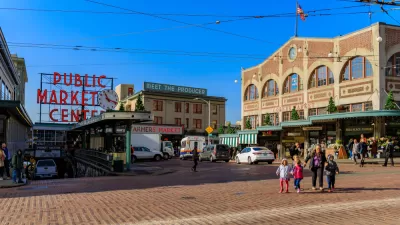Farmers Markets have exploded over the past decade. This phenomenon has not only brought more vegetables to cities but revitalization in the public.
Nothing quite says springtime like a farmer’s table loaded with kale, mustard greens, and spinach. And with the arrival of warmer days, soon communities will be enjoying the benefits of fresh, locally grown produce. Though farmers markets are often criticized over affordability and exclusivity, the appetite for them has grown significantly. In 1994, there were 1,700 markets nationwide; now, there are more than eight thousand. The proliferation of baby bok choy is indeed cause for praise. Markets help circulate dollars locally. More vegetables mean slimmer waistlines. And farmers markets can revitalize neighborhoods. These markets can also serve as a setting for what Jane Jacobs called the “sidewalk ballet,” a public space connecting people to each other. Their diverse functions—shopping, eating, or simply engaging neighbors—facilitate social interactions. In fact, the farmers market is unfortunately one of the few remaining civic places that facilitates such shared public encounters.
The decline of mixed public spaces can be traced back to the early twentieth century, when public officials began partitioning cities into areas based on functionality. At first, zoning was a public health initiative, especially in industrial cities plagued with unregulated pollution, rubbish disposal, and sewage handling. To keep factories and housing far apart, urban planners created restricted residential and industrial zones. However, a form of zoning logic, known as redlining, began to isolate populations of the city along lines of race and class. (The effects of redlining became more pronounced by the mid-twentieth century.) With the further help of the automobile and the suburbs, American cities became even more demographically and functionally divided.
FULL STORY: The Triumph of the Farmers Market

Maui's Vacation Rental Debate Turns Ugly
Verbal attacks, misinformation campaigns and fistfights plague a high-stakes debate to convert thousands of vacation rentals into long-term housing.

Planetizen Federal Action Tracker
A weekly monitor of how Trump’s orders and actions are impacting planners and planning in America.

In Urban Planning, AI Prompting Could be the New Design Thinking
Creativity has long been key to great urban design. What if we see AI as our new creative partner?

King County Supportive Housing Program Offers Hope for Unhoused Residents
The county is taking a ‘Housing First’ approach that prioritizes getting people into housing, then offering wraparound supportive services.

Researchers Use AI to Get Clearer Picture of US Housing
Analysts are using artificial intelligence to supercharge their research by allowing them to comb through data faster. Though these AI tools can be error prone, they save time and housing researchers are optimistic about the future.

Making Shared Micromobility More Inclusive
Cities and shared mobility system operators can do more to include people with disabilities in planning and operations, per a new report.
Urban Design for Planners 1: Software Tools
This six-course series explores essential urban design concepts using open source software and equips planners with the tools they need to participate fully in the urban design process.
Planning for Universal Design
Learn the tools for implementing Universal Design in planning regulations.
planning NEXT
Appalachian Highlands Housing Partners
Mpact (founded as Rail~Volution)
City of Camden Redevelopment Agency
City of Astoria
City of Portland
City of Laramie



























